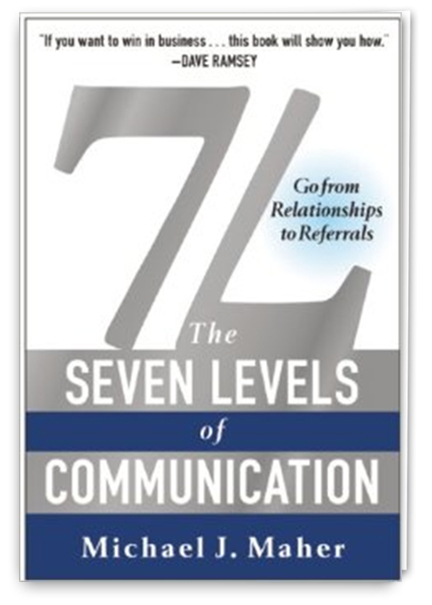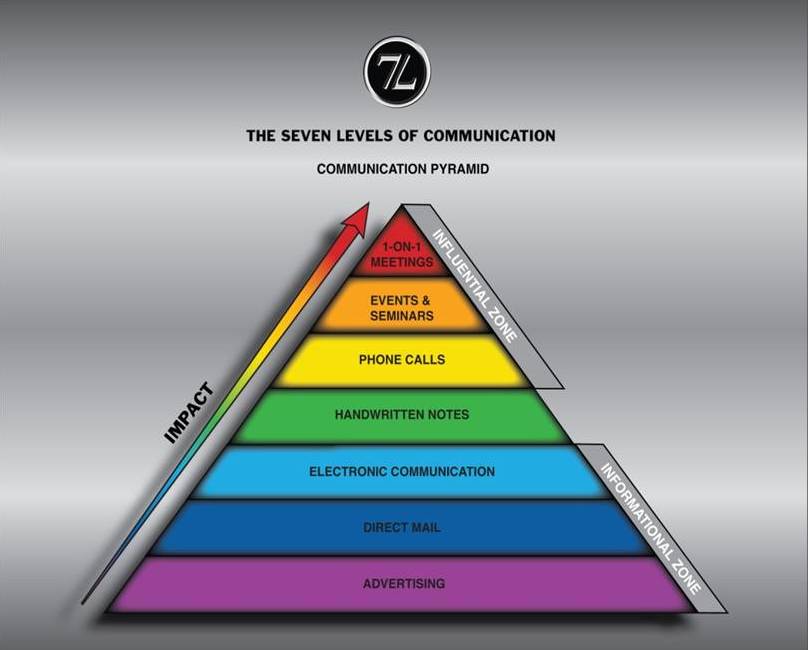INSIDER: The Seven Levels of Communication
John Tran, MBA Candidate

“In the old days, the only way to get business was cold-calling, door-knocking, and other ways to ‘market to strangers.’ Everybody spent time and money trying to attract and close people they’d never met. In the Generosity Generation, we can spend our time, energy, effort, and money on people we actually like and trust. In the end, those are the ones who are most valuable to our business.” (Maher 2014)
Michael J. Maher, the author of The Seven Levels of Communication,is known as, North America’s Most Referred Real Estate Professional, and also as the founder of the Generosity Generation. The author describes the generation preceding the Generosity Generation as the Ego Era. In the Ego Era, sales professionals traditionally marketed to customers and consumers through advertisements and self-promotion. The author argues that traditional mass marketing is no longer effective. The Seven Levels of Communication emphasizes the power of reciprocity, and that genuinely wanting to serve others will eventually lead to financial and other meaningful gains. The book follows the fictional journey of a real estate agent named Rick Masters as he becomes a member of the Generosity Generation and grows his business beyond what he had ever imagined.
THINK POINT #1: The Seven Levels of Communication
A communication pyramid’s structure is such that as a real estate agent moves up the pyramid, he or she will have more of a significant impact and the client relationship will grow stronger. Advertising, direct mail, and electronic communication comprise the bottom three levels of the pyramid, or what is known as the informational zone. Real estate agents and sales professionals should use this zone when wanting to inform, confirm, or update their clients. Phone calls, events and seminars, and one-on-one meetings make up the top three levels of the pyramid, known as the influential zone. Professionals should utilize this zone when wanting to influence, convince, or sell.
The middle level of the pyramid involves communication through handwritten notes. In the book the author introduces the concept of POWER notes: Personal, Optimistic, Written, Effective, and Relational notes that help build relationships with clients and get responses. There are 7 steps to an effective POWER Note:
- Use unbranded cards with a symbol or monogram that represents you. Remember, it is a personal note.
- Write with blue ink which looks original and positive.
- Emphasize the word “you” as much as possible and avoid words “I”, “me”, and “we.” You may use “we” when speaking in terms of the person you are writing and yourself, such as “we make a great team.”
- Be specific in your praise. Identify and acknowledge a characteristic, a talent, and/or a unique quality.
- Leverage the power of positive projection. Identify a personal characteristic you want to improve and express respect for others who possess that quality (happiness, wealth, balance, etc.)
- Write rightly – slope text slightly upward from left to right. Read Rodgers’ book, Your Handwriting Can Change Your Life.
- Use a P.S. as a call-to-action: Ask the recipient to take action such as emailing or calling.
Source:Maher (2014)
(Click image to enlarge/shrink)
Real estate professionals can write POWER notes to anyone and everyone, whether they are in their network or not. POWER notes serve as an effective call-to-action that will help a sales professional generate responses, build relationships, and grow business.
THINK POINT #2: Utilizing Your Network
Maher argues that a real estate professional’s network can be a bigger source of business than originally considered. The National Association of REALTORS® estimates that on average, an individual will move once every five years. If you have a network of 150 people, 30 people will be moving each year. If a real estate agent completed 30 transactions in 2013, he or she would be in the top 10% of realtors in the United States. If each individual moving that year bought and sold property, that would equate to 60 transactions a year from a network of 150 clients. Maher continues to elaborate on the importance of a network by stating that the average wedding has 250 guests. If a network consisted of 150 clients, where each client is only connected to 150 other individuals, the number of people in your network and who they are connected to equals 22,500. These 22,500 individuals are now your Community, and as a real estate agent, 20% of those individuals plan on moving once every 5 years. That’s 4500 people in your community who are moving, and 9000 potential transactions available to a real estate agent, all from a network of just 150 clients.
The Communication Pyramid is a great way to reach out to all of the members in your community, especially leveraging POWER notes to the top levels of the communication pyramid. A way for sales professionals to further impact their network is by understanding the four behavioral styles – DISC:
D – Dominance. Individuals who are straight to the point, usually driven, fast-paced, efficient, and brutally honest. They do not like long explanations: they prefer the bottom line.
I – Influence. I’s love to socialize and are usually outgoing, friendly, energetic, and emotional. I’s are the life of the party.
S – Steadiness. An S is dependable, s/he loves to nurture and lives to please others. S’s prefer predictability and security over spontaneity.
C – Compliance. C’s are perfectionists who expect everyone to comply with the rules, they crave order and process.
Maher shared a poem entitled, The DISCovery:
Smile like Everyone’s an I,
Care like Everyone’s an S,
Prepare like Everyone’s a C,
And Sell like Everyone’s a D.
Sales professionals who genuinely understand the four behavioral styles and adjust their methods of communication accordingly do a better job of building trust with their clients, and trust leads to deeper relationships with more referrals.
THINK POINT #3: Self Help
The Seven Levels of Communication focuses on improving one’s self in order to better serve others. Maher uses the acronym LIFE to further illustrate his points on the value of self-improvement. LIFE stands for Learn, Implement, Fail, and Evaluate. Everyone fails, but some fail at a higher level. Life is a spiral staircase and as one moves up, s/he will fail. Failure is part of life. When an individual learns from his/her failures and implements new knowledge, s/he continues to move up the staircase until failing again. The most successful sales professionals fail very often and at very high levels, meaning they are constantly climbing up the staircase of life.
Conclusion
The Generosity Generation suggests that acts of generosity and kindness will be rewarded in the business world. When business is all about the customer or consumer, business is really all about relationships. Maher’s Seven Levels of Communication serves as a guide to remind real estate professionals fostering meaningful relationships and growing your business result from intentional communication activities.
Rainmaker’s Affirmation – “Each and every day, someone, somewhere in my city, needs my services. My job TODAY is to find that person.”
. . . . . . . . . . . . . . . . . . .
Recommended Reading
Maher, M. (2014), The Seven Levels of Communication. Dallas: BenBella Books.
Reference
Rodgers, V. (2000), Your Handwriting Can Change Your Life, New York: Simon & Schuster.
. . . . . . . . . . . . . . . . . . .
About the Author
John Tran, MBA Candidate, Baylor University
John Tran is a graduate student from Dallas, Texas. He earned his bachelor’s degree in Business Administration with a concentration in Healthcare Management at the University of Texas at Dallas. Before enrolling at Baylor, John worked at both the American Heart Association and Texas Health Presbyterian Hospital in Dallas. John is currently pursuing an MBA with a concentration in healthcare and planning a career in hospital business operations.
.jquery-image-zoom { z-index: 999; }


